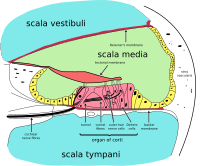
Photo from wikipedia
Exposure to blast overpressure or high-intensity sound can cause injuries to the auditory system, which leads to hearing loss or tinnitus. In this study, we examined the involvement of peripheral… Click to show full abstract
Exposure to blast overpressure or high-intensity sound can cause injuries to the auditory system, which leads to hearing loss or tinnitus. In this study, we examined the involvement of peripheral auditory system (PAS), and central auditory system (CAS) changes after exposure to blast overpressure (15-25 psi) on Day 1 and additionally during 7 days of post blast time period in chinchillas. Auditory brainstem response (ABR), distortion product otoacoustic emission (DPOAE), and cochlear hair cell changes were measured or identified in post-blast period within 7 days to detect injuries in the PAS. In the CAS, changes in NMDAR1 (excitatory receptor) and GABAA (inhibitory receptor) as well as changes in serotonin (5-HT2A) and acetylcholine (AChR) receptors were examined in different brain regions: auditory cortex (AC), geniculate body (GB), inferior colliculus (IC) and amygdala by immunofluorescence staining. We observed the PAS abnormalities of increased ABR threshold and decreased DPOAE response in animals after blast exposure with hearing protection devices (e.g., earplug). Blast exposure also caused a reduction in both NMDAR1 and GABAA receptor levels in acute condition (post-blast or Day 1) in AC and IC, while serotonin and acetylcholine receptor levels displayed a biphasic response at Day 1 and Day 7 post-exposure. Results demonstrate that the earplug can protect the tympanic membrane and middle ear against structural damage, but the hearing level, cochlear outer hair cell, and the central auditory system (levels of excitatory and inhibitory neurotransmitter receptors) were only partially protected at the tested blast overpressure level. The findings in this study indicate that blast exposure can cause both peripheral and central auditory dysfunctions, and the central auditory response is independent of peripheral auditory damage. The CAS dysfunction is likely mediated by direct transmission of shockwaves in all the regions of central nervous system (CNS), including nerves and surrounding tissues along the auditory pathways. Hence, targeting central auditory neurotransmitter abnormalities may have a therapeutic benefit to attenuate blast-induced hearing loss and tinnitus.
Journal Title: Hearing Research
Year Published: 2021
Link to full text (if available)
Share on Social Media: Sign Up to like & get
recommendations!